Ripley Entertainment Inc.'s Blog, page 336
June 22, 2018
CARTOON 06-22-2018
June 21, 2018
Your Doves Are Pigeons And Other Wedding Lies
Featured in Ripley's Believe It or Not!

Or Not
In today’s world many misconceptions have been perpetuated—becoming modern day “facts”—when, in reality, myths and hearsay have taken over. Sorry to burst your bubble, but in this weekly column, Ripley’s puts those delusions to the test, turning your world upside down, because you can’t always…Believe It!
Today: Marriage Myths.
While wedding ceremonies around the world feature an assortment of superstitions, some Western traditions are a complete deception. Make sure your wedding doesn’t end up a sham by avoiding these two popular misconceptions.
Rice Will Not Make Birds Explode
This rumor has been around since the 1980s. While throwing rice on an egressing bride and groom has long been a tradition, a rumor spread like wildfire in recent decades that you shouldn’t throw rice because it’s bad for birds. This myth has been written in newspapers, gossiped by mothers-in-law, and even made its way to the Connecticut State legislature. They claimed that when birds ate raw rice, it expanded in their stomach causing painful deaths as their bodies ruptured.
The “Act Prohibiting the Use of Uncooked Rice at Nuptial Affairs” would fine rice-throwers $50 in reparations for harming the birds. Representative Mae Schmidle—who introduced the bill—claimed to have the full support of the Audubon Society, but when newspapers contacted members, they said it was preposterous.
First of all, many birds eat raw rice in the wild, much to the chagrin of rice growers. Some birds, like migrating geese, even depend on stopping at rice fields to fatten themselves up for their winter journeys. Furthermore, rice only expands about 33% of its size when exposed to liquids for a very long time (not nearly as much as some seeds, even). Bird’s digestive systems work too quickly for a rice grain to expand drastically.
Though avian rice bombs were never seen before, some people think the idea is intended to keep people from throwing instant rice—which can expand up to 400% of its original volume. Thankfully, some researchers were willing to disprove this theory with their own pigeons. After running some simulations with plastic bags, they coerced their professor to let them feed instant rice to his pigeons. On a diet of nothing but instant rice and water for a whole day, none of the birds turned into bombs or showed any signs of discomfort.
Your Doves Are Pigeons
Speaking of pigeons, they’re actually quite popular at weddings, too. Most people think that doves are being released in celebration of their marriages, but the birds are actually just white pigeons.
Doves have long been symbols for love and peace in both ancient Greek and Judeo-Christian religions. They were sacred to the goddess of love, Aphrodite, and a pair signified unity in much of the Christian art following the reign of Constantine. It’s no surprise many couples love the idea of releasing two doves to celebrate their marriage, but unfortunately, real doves aren’t very good for this. Instead, breeders often use a breed of white homing pigeons. These pigeons have a well refined homing ability, meaning they can find their way back to the breeder even across vast distances. They are also much more survivable in the open than most breeds of doves.

Dove and pigeons are in the same family of birds—Columbidae—but have a few key differences and are easily confused with each other. Doves and pigeons have also been long used inconsistently even by ornithologists. Currently, what most what consider a feral city pigeon is technically referred to as the rock dove by today’s standard, with subspecies all being called pigeons.
Don’t let your marriage start on lies; throw rice and admire pigeons to your heart’s content. Just be prepared to clean the rice out of your pockets afterward!
CARTOON 06-21-2018
June 20, 2018
Odd Cakes Come To Ripley’s San Antonio 30th Anniversary!
Featured in Ripley's Believe It or Not!
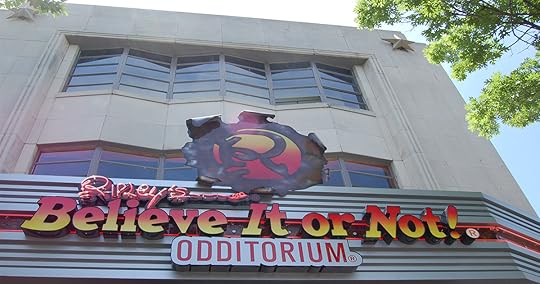
Cake has almost always been a symbol of celebration. Rich with rituals and culture, cakes were used as offerings to the gods, dating as far back as ancient Egyptian times. Here at Ripley’s, we’ve seen every kind of cake there is, but the question is—have you?
Take for instance the world’s most gruesome cake shop that popped up in the Pathology Museum at St. Bart’s Hospital, London, England. The pop-up bakery featured creepy confectionery such as a bleeding heart perched on a wedding cake and a stitched-skin cake.
The brainchild of Emma Thomas (aka Miss Cakehead), the three-day “Eat Your Heart Out” event graphically represented diseases and body parts in edible form. Many of the foodstuffs were so lifelike they made visitors wretch.
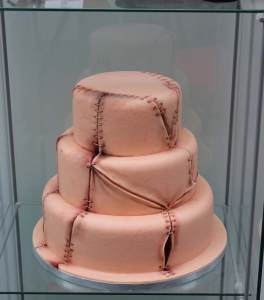
Similarly, Annabel de Vetten from Birmingham, England, made these disturbingly realistic, life-sized baby heads out of solid white chocolate.

Based in St. Petersburg, Russia, baker Zhanna creates intricately realistic cakes of anything you can imagine, and they are 100 percent edible.
Did you know there was a giant wedding cake that measured 15½ feet tall and was baked for the county fair in Ferndale, California, in the 1950s? It fed more than 1,500 people!
30 Years At San Antonio
To celebrate our 30th anniversary at Ripley’s Believe It or Not! San Antonio, we will be serving cupcakes from Nadler’s Baker & Deli and judging our Oddest Cake Contest! Judging will take place at Louis Tussaud’s Waxworks at 301 Alamo Plaza.
On Friday, June 22nd, join us early to continue the celebration! The first 100 paid guests will receive a gift and a slice of cake (before it runs out)! Just note, there will be no women jumping out of cakes. While the tradition is still popular, do you know how it really started?
First San Antonio Contest
Believe it or not, when we first opened our San Antonio Odditorium, we held an “Amazing Survival” contest where locals came in and pitched us their Believe It or Not! stories. We heard some unbelievable tales!
In 1971, Tom Thompson was struck by a car at age 15. Thompson lost a large portion of his skull and was not expected to live. Comatose for almost six months, Tom’s missing skull fragments were replaced in a series of operations by a 4″ x 3″ metal plate, which was bolted to his existing skull. Following many procedures, Thompson lived a perfectly normal life as a school teacher in San Antonio, Texas!

Of course, Thompson’s story won our contest. His metal plate X-rays were new exhibits in our Amazing Survivals section of the Ripley’s Believe It or Not! Odditorium in San Antonio. There were many pictures on the wall behind Thompson of other amazing survivals on display but nothing compared to his. You can now see his X-rays on display at our New York Odditorium.
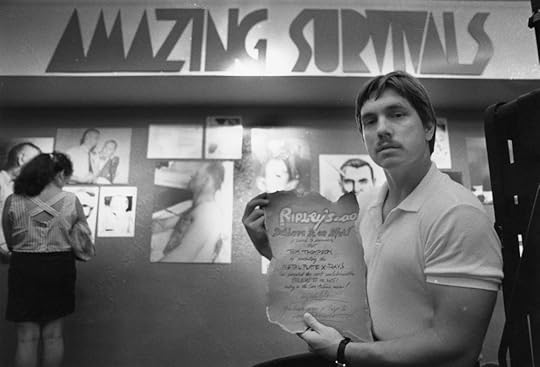
Do you have an unbelievable story, photo, or pet? Make sure you share it with us by using our exclusive Snapchat filter to celebrate our 30th anniversary at our San Antonio location. Want to find out how you can help celebrate with us? Click here to get exclusive access to our birthday celebration invitation.
The Origin Of Our San Antonio Odditorium

San Antonio Odditorium grand re-opening.
The story begins on a stormy night, when Drew Hunter (Former Creative Director for Classic Attractions) was driving into Dallas listening to “Night on Bald Mountain” (the big, epic finale song in Fantasia).
“I kid you not, the moment I parked my car at the first wax museum we had at the Grand Prairie location—now known as Louis Tussaud’s Palace of Wax—the song ended right there. I knew that my life was about to change that day.”
And change it did. Bill Phillips (Phillips Entertainment Franchise Partners) wanted Drew to find and create a mind-blowing Ripley’s Believe It or Not! Odditorium. They found the perfect location at an empty H. L. Green department store. After scoping the area for a time, a plan was drafted and it was time to meet up with Norm Deska (EVP Intellectual Property) and Edward Meyer (VP of Exhibits and Archives).
“I’ll never forget. We were sitting outside on a patio area of Scarlett O’Hara’s in St. Augustine just talking, eating, and having a good time. I ran up to the hotel, and I realized I couldn’t find the plans for the museums.”
Frantic, he called Bill, who helped him retrace his tracks. Drew returned to the bar, banging on the door asking if they had found any paper. No luck.
“I thought, We have a meeting tomorrow morning. What am I going to do?”
Luckily enough, he brought all his tools with him and—by hand—drew out the plans from memory. It took him the whole night. Norm and Edward loved the plans, but Drew never said a word about what happened the night before…until now.

Edward and Drew today!
The next step was to find exhibits they wanted to showcase in San Antonio. With our warehouse then located in St. Augustine, it was a perfect time to find what they needed. Drew fell in love with The Devil and Damsel two-sided sculpture. Carved in Germany in the 19th century out of fruitwood, one side shows Margaret from Goethe’s Faust, and the other side shows Mephistopheles, the demon. Drew painted a mural at the San Antonio location to give a one-of-a-kind scenic view for the exhibit.

During construction, Drew loved to play tricks on his workers. Unbeknownst to the staff, there was an enclosed area under a stairway (where the wax museum is today) that needed to be cleaned up. Drew decided to create a creepy document with fake dry blood and place strange mystical signs all over it. Inside, he wrote that whoever opened this space would release an unknown evil force that would be impossible to tame.
“Oh man, I even put melted candles next to the mystical letter,” said Drew. “A couple of the workers were completely freaked out. Others just walked out!”
While the Odditorium has undergone some improvements and moved in right next door to our Waxworks, our history is as rich as cake! We want to wish San Antonio a happy 30th birthday, and most importantly, celebrate it for keeping this amazing city as weird as ever!
Source: Odd Cakes Come To Ripley’s San Antonio 30th Anniversary!
Odd Cakes Come to Ripley’s San Antonio 30th Anniversary!
Featured in Ripley's Believe It or Not!

Cake has almost always been a symbol of celebration. Rich with rituals and culture, cakes were used as offerings to the gods, dating as far back as ancient Egyptian times. Here at Ripley’s, we’ve seen every kind of cake there is, but the question is—have you?
Take for instance the world’s most gruesome cake shop that popped up in the Pathology Museum at St. Bart’s Hospital, London, England. The pop-up bakery featured creepy confectionery such as a bleeding heart perched on a wedding cake and a stitched-skin cake.
The brainchild of Emma Thomas (aka Miss Cakehead), the three-day “Eat Your Heart Out” event graphically represented diseases and body parts in edible form. Many of the foodstuffs were so lifelike they made visitors wretch.

Similarly, Annabel de Vetten from Birmingham, England, made these disturbingly realistic, life-sized baby heads out of solid white chocolate.

Based in St. Petersburg, Russia, baker Zhanna creates intricately realistic cakes of anything you can imagine, and they are 100 percent edible.
Did you know there was a giant wedding cake that measured 15½ feet tall and was baked for the county fair in Ferndale, California, in the 1950s? It fed more than 1,500 people!
30 Years At San Antonio
To celebrate our 30th anniversary at Ripley’s Believe It or Not! San Antonio, we will be serving cupcakes from Nadler’s Baker & Deli and judging our Oddest Cake Contest! Judging will take place at Louis Tussaud’s Waxworks at 301 Alamo Plaza.
On Friday, June 22nd, join us early to continue the celebration! The first 100 paid guests will receive a gift and a slice of cake (before it runs out)! Just note, there will be no women jumping out of cakes. While the tradition is still popular, do you know how it really started?
First San Antonio Contest
Believe it or not, when we first opened our San Antonio Odditorium, we held an “Amazing Survival” contest where locals came in and pitched us their Believe It or Not! stories. We heard some unbelievable tales!
In 1971, Tom Thompson was struck by a car at age 15. Thompson lost a large portion of his skull and was not expected to live. Comatose for almost six months, Tom’s missing skull fragments were replaced in a series of operations by a 4″ x 3″ metal plate, which was bolted to his existing skull. Following many procedures, Thompson lived a perfectly normal life as a school teacher in San Antonio, Texas!

Of course, Thompson’s story won our contest. His metal plate X-rays were new exhibits in our Amazing Survivals section of the Ripley’s Believe It or Not! Odditorium in San Antonio. There were many pictures on the wall behind Thompson of other amazing survivals on display but nothing compared to his. You can now see his X-rays on display at our New York Odditorium.

Do you have an unbelievable story, photo, or pet? Make sure you share it with us by using our exclusive Snapchat filter to celebrate our 30th anniversary at our San Antonio location. Want to find out how you can help celebrate with us? Click here to get exclusive access to our birthday celebration invitation.
The Origin Of Our San Antonio Odditorium

San Antonio Odditorium grand re-opening.
The story begins on a stormy night, when Drew Hunter (Former Creative Director for Classic Attractions) was driving into Dallas listening to “Night on Bald Mountain” (the big, epic finale song in Fantasia).
“I kid you not, the moment I parked my car at the first wax museum we had at the Grand Prairie location—now known as Louis Tussaud’s Palace of Wax—the song ended right there. I knew that my life was about to change that day.”
And change it did. Bill Phillips (Phillips Entertainment Franchise Partners) wanted Drew to find and create a mind-blowing Ripley’s Believe It or Not! Odditorium. They found the perfect location at an empty H. L. Green department store. After scoping the area for a time, a plan was drafted and it was time to meet up with Norm Deska (EVP Intellectual Property) and Edward Meyer (VP of Exhibits and Archives).
“I’ll never forget. We were sitting outside on a patio area of Scarlett O’Hara’s in St. Augustine just talking, eating, and having a good time. I ran up to the hotel, and I realized I couldn’t find the plans for the museums.”
Frantic, he called Bill, who helped him retrace his tracks. Drew returned to the bar, banging on the door asking if they had found any paper. No luck.
“I thought, We have a meeting tomorrow morning. What am I going to do?”
Luckily enough, he brought all his tools with him and—by hand—drew out the plans from memory. It took him the whole night. Norm and Edward loved the plans, but Drew never said a word about what happened the night before…until now.

Edward and Drew today!
The next step was to find exhibits they wanted to showcase in San Antonio. With our warehouse then located in St. Augustine, it was a perfect time to find what they needed. Drew fell in love with The Devil and Damsel two-sided sculpture. Carved in Germany in the 19th century out of fruitwood, one side shows Margaret from Goethe’s Faust, and the other side shows Mephistopheles, the demon. Drew painted a mural at the San Antonio location to give a one-of-a-kind scenic view for the exhibit.

During construction, Drew loved to play tricks on his workers. Unbeknownst to the staff, there was an enclosed area under a stairway (where the wax museum is today) that needed to be cleaned up. Drew decided to create a creepy document with fake dry blood and place strange mystical signs all over it. Inside, he wrote that whoever opened this space would release an unknown evil force that would be impossible to tame.
“Oh man, I even put melted candles next to the mystical letter,” said Drew. “A couple of the workers were completely freaked out. Others just walked out!”
While the Odditorium has undergone some improvements and moved in right next door to our Waxworks, our history is as rich as cake! We want to wish San Antonio a happy 30th birthday, and most importantly, celebrate it for keeping this amazing city as weird as ever!
Source: Odd Cakes Come to Ripley’s San Antonio 30th Anniversary!
The 1960s Android Abandoned By NASA
Featured in Ripley's Believe It or Not!
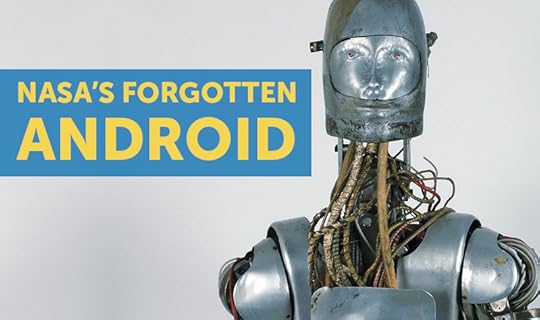
In May of 1961, President John F. Kennedy delivered a speech to the American people promising a successful Moon landing by the end of the decade. Neil Armstrong would eventually take the first steps on the lunar surface in 1969, but in the years between the two legions of engineers, scientists, and astronauts would develop the technology need for safe and effective space flight. A forgotten stepping stone in the rich history of space travel is an android built in 1965.
Named Project No. K6501, engineer Joe Slowik created a Power-Driven Articulating Dummy (PDAF). The robot was intended to be used in testing different spacesuits. While it was typical for astronauts to put on spacesuits and give verbal feedback as to whether they were comfortable or allowed for freedom of motion, designers wanted something more objective. They wanted measurements of resistance and stress, and they wanted to compensate for varying sizes.
K6501 was designed to cover 95% of all body sizes and shapes. His height was adjustable from 5-foot-five to 6 feet 2 inches tall. The bot was built on an aluminum skeleton with wires and hydraulic lines all throughout. Portions of the frame were covered in aluminum skin and a fiberglass astronaut head with red eyes. The dummy was highly advanced for its time. The miniaturized hydraulic valves in its joints allowed it a full range of motion. K6501 could shake hands and sway its hips like Elvis Presley.
Though the 230-pound robot was capable of holding light weights and grasping small objects and had no ability to balance itself upright. It had to be cabled upright for testing. The engineers achieved their goal of creating a human-sized robot with human-like movements, but unfortunately, there was a problem: he leaked.
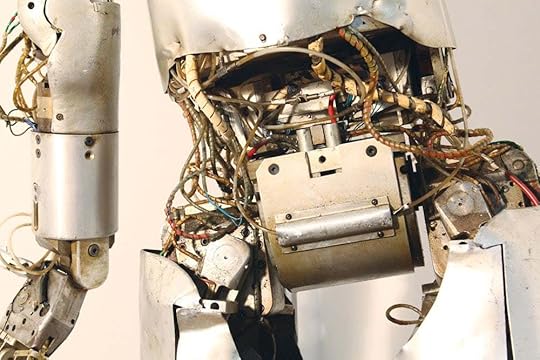
The tiny hydraulic servos required 10,000 pounds of fluid-force to articulate the skeleton, and materials technology at the time couldn’t keep up. The leaking fluid could ruin a one-of-a-kind spacesuit and cost the equivalent of $750,000 today, according to Slowik. They tried putting him in a scuba-suit, but by July of 1965, the project was disbanded.
Two K6501 robots were ultimately produced. One was taken in by the United States Air Force Bionics program, where they tried converting his joints to electric servos and planned to attach him to a learning computer. Despite years of work, the android project was scrapped. The experimental automaton now resides in the National Aeronautics and Space Museum.
The other bot had short tenures at Universities but eventually ended up for sale at auction. The “escaped” bot suffered some damage—losing an arm. For just $24,000 someone took home their very own sci-fi space experiment from the 1960s. K6501 may have just been a dummy, but today, NASA actually uses an android on the International Space Station.
Robonaut-2 is a highly dexterous android built for space missions. He has a multitude of cameras and processors. Though he can only lift 20 pounds on Earth, his strength is plenty for the microgravity of space. Originally just a torso, NASA was just mounting him in various places he was needed but has now fitted him with a pair of legs. Robonaut allows Mission Control to carry out simple, repetitive tasks without the need to rest or risk to human life.

CARTOON 06-20-2018
June 19, 2018
Up Close With A Vampire Killing Kit
Featured in Ripley's Believe It or Not!
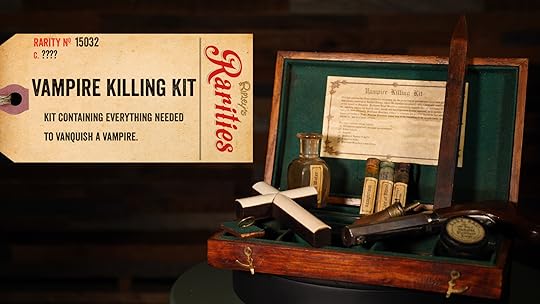
Vampire-like creatures have been described in myths, legends, and tales for millennia, but the vampire craze of the 17th-century is still apparent today. People in the eastern reaches of Europe were so scared of vampires that they took precautions lasting to this day. A graveyard in Poland, for example, was discovered to have people shackled at the neck.
As Bram Stoker’s Dracula swept Victorian England, vampire fears finally made it out of Europe, and travelers toured the hills of Transylvania with grave caution.
The vampire is first and foremost an undead being who rises from the grave to feed on blood. The particulars of how this works vary from story to story, but many involve curses or deals with the devil.
A vampire’s abilities and weaknesses are as varied as their origins and appearance. Traditionally, they were horrid and frightening, but as Victorian sentiments were injected into the mythos by Stoker, vampires could also be seductive.
While there are indeed real bats who feast on human blood, the vampire was said to shapeshift into all sorts of things, including wolves and clouds of mist. They were rumored to control rats, wolves, and maggots. They could hypnotize people in their sleep, teleport, and even propagate their powers to minor thralls.
Despite the vampire’s vast arsenal of advantages over the common person, history has always featured ways to fight the undead. The many vampire killing kits in the Ripley’s collection contain everything one would need to fight a vampire.
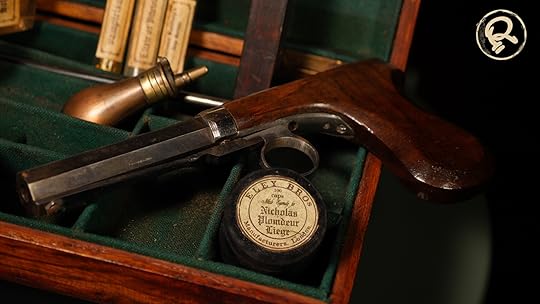
The kit featured here includes a wooden stake for destroying the heart of a vampire—one of the few ways to permanently kill a vampire, according to legends. A cross and holy water have also long been countermeasures against the undead—the antithesis to their supposed satanic origins. The gun and equipment for making silver bullets may seem like they were better suited to fighting a werewolf, but you’d have to assume that European travelers’ own ideas of what’s used to fight a vampire match our own.
If the gun seems questionable, look closer at the vials. We can only guess what “Professor Blomberg’s New Serum” is. The Elixir of Vitriol is less cryptic, often a name for a stomach tonic including sulfuric acid, but the vial simply labeled “vampirism” brings us back to mystery.
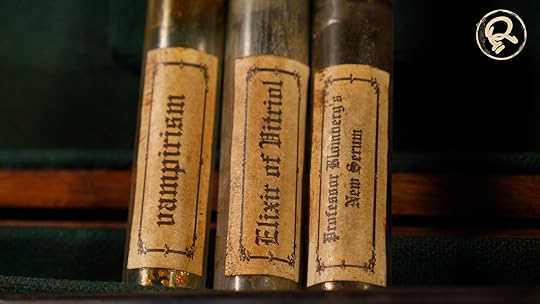
While Ripley’s has been able to authenticate the age of some of the components in these kits—the firearms most notably—we can’t be as certain that the boxes, crucifixes, or other contents were assembled in the same time period. Perhaps sometime later to give the impression of an old-timey vampire hunting ensemble. Were they sold to witlessly terrified travelers in the forests of Transylvania? Were they assembled later by mysterious individuals for purposes unknown? Either way, these kits are real; they exist and can be seen in-person in our many odditoriums.
CARTOON 06-19-2018
June 18, 2018
Feet Keep Washing Ashore In Canada, Sneaker Tech May Be The Culprit
Featured in Ripley's Believe It or Not!
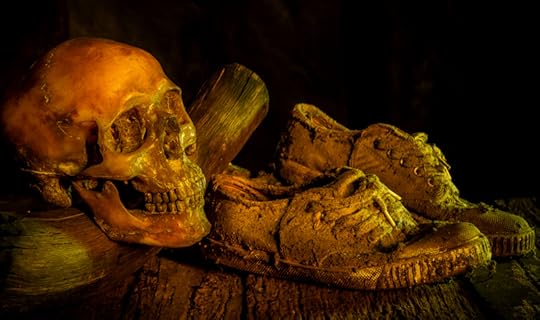
Ocean tides have deposited 14 human feet on the shoreline of a Canadian province over the past decade, and the deceased’s preference for activewear may be the cause of the unusual phenomenon.
Beginning in 2007, 13 feet clad in sneakers have washed ashore in British Columbia. A man walking on the beach on Gabriola Island on the Strait of Georgia discovered the 14th foot on May 6, 2018. The appendage was attached to a hiking boot and was stuck in a logjam, reported the Royal Canadian Mounted Police.
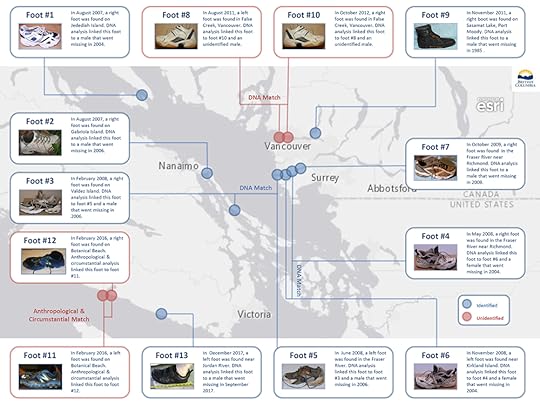
Missing feet locations from the BC Coroner’s Office.
Advances in sneaker technology may be the reason why so many detached feet are making their way to Canada’s westernmost province. Barb McLintock of the B.C. coroner’s office noted in 2016 that new styles of sneakers often contain lightweight foam that “eventually allows them to be light enough to float and to wash up on shore.” Because the sneakers are so durable, they protect the feet from decomposing.
Many athletic shoes contain mesh, which makes them breathable but also more buoyant than footwear made out of other materials (i.e., leather). Synthetics also reduce the weight of the sneakers. New brands feature cushioning that makes the wearer feel as though he or she is walking on air. Adidas Boost technology, for example, includes foam cushioning that does not break down very easily.
It’s unclear where the detached feet are coming from, but theories have ranged widely from natural disasters to airplane and ship accidents. Some have even speculated the feet are from victims of serial killers, the mob, or even aliens.
However, authorities have assured the public that no foul play is suspected in any of the cases because there have been no signs of trauma. The individuals either died accidentally, possibly from storms near the coast or took their own lives. Drownings aren’t uncommon near oceans or lakes, and occasionally the bodies of people who die of natural causes near a shoreline wind up in the ocean.

CC Dennis Bratland
During decomposition, the feet naturally disarticulate from the bodies, a process that happens quicker in water than on land. The deceased ones’ sneakers protect the appendages, preventing sea creatures from gobbling them up.
Over the years, some people have tried to trick authorities by placing chicken bones, raw meat, and dog foot skeletons in sneakers and leaving them on the beach for people to find.
The 13th foot appeared in December 2017 on the southern coast of Vancouver Island. It belonged to an elderly man from Washington state who had gone missing and was later found dead.
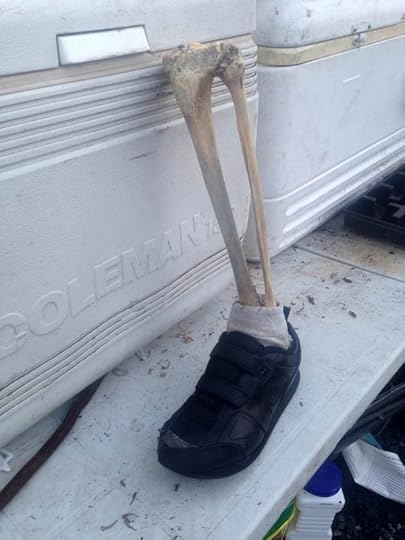
The 13th sneaker/Credit Mike Johns via B.C. Coroner’s Office
B.C. is a magnet for detached feet because of tide and current patterns. Its shoreline is part of the Salish Sea, a body of water that includes the Puget Sound and Strait of Georgia. Some items that float in the ocean are pushed by the wind, which in the Salish sea moves west to east. Feet have also washed up in Washington state.
Leg-In-Boot Square in Vancouver, B.C., was reportedly named after an incident in 1887 in which a boot with half a human leg attached to it washed up on the shores of False Creek.
Authorities have thus far identified eight of the detached feet, two of which were pairs. The remaining single feet are male. The DNA from the feet can be difficult to analyze depending on the amount of time the appendages have spent decaying in salt water.
Water temperature plays a big role in the rate of decomposition. Cold water promotes the growth of a waxy, soapy substance called adipocere, which partially preserves a body. In waters below 7°C, it’s not uncommon for bodies to remain almost completely unblemished for several weeks. Eventually, the skin will absorb water and peel away from the body.
In tropical water, a body will float to the surface within days, and sea creatures and birds will dismember it within a week or two.
By Noelle Talmon, contributor for Ripleys.com
Source: Feet Keep Washing Ashore In Canada, Sneaker Tech May Be The Culprit
Ripley Entertainment Inc.'s Blog
- Ripley Entertainment Inc.'s profile
- 52 followers







